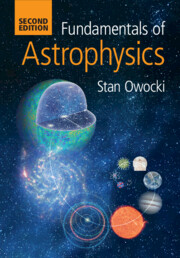Refine listing
Actions for selected content:
17002 results
The Physics of Interstellar Travel
- Coming soon
-
- Expected online publication date:
- June 2026
- Print publication:
- 31 July 2026
-
- Book
- Export citation

Ordinary Chondrites
- The Most Common Meteorites
- Coming soon
-
- Expected online publication date:
- April 2026
- Print publication:
- 30 April 2026
-
- Book
- Export citation
Gravitation for Theorists
- Coming soon
-
- Expected online publication date:
- February 2026
- Print publication:
- 28 February 2026
-
- Book
- Export citation

Quantum Cosmology
- An Introduction
- Coming soon
-
- Expected online publication date:
- January 2026
- Print publication:
- 28 February 2026
-
- Book
- Export citation

Quasar Absorption Lines
- Coming soon
-
- Expected online publication date:
- November 2025
- Print publication:
- 18 December 2025
-
- Book
- Export citation

Quasar Absorption Lines
- Coming soon
-
- Expected online publication date:
- November 2025
- Print publication:
- 18 December 2025
-
- Book
- Export citation

Fundamentals of Astrophysics
-
- Published online:
- 10 November 2025
- Print publication:
- 24 July 2025
-
- Textbook
- Export citation
Planetary Science and Exoplanets in the Era of JWST (IAU S393)
- Coming soon
-
- Expected online publication date:
- November 2025
- Print publication:
- 31 December 2025
-
- Book
- Export citation
References
-
- Book:
- Martian Impact Craters
- Published online:
- 09 October 2025
- Print publication:
- 30 October 2025, pp 150-159
-
- Chapter
- Export citation
Abbreviations
-
- Book:
- Martian Impact Craters
- Published online:
- 09 October 2025
- Print publication:
- 30 October 2025, pp xiii-xiv
-
- Chapter
- Export citation
9 - Remaining Puzzles Concerning Martian Craters
-
- Book:
- Martian Impact Craters
- Published online:
- 09 October 2025
- Print publication:
- 30 October 2025, pp 128-147
-
- Chapter
- Export citation
Appendix
-
- Book:
- Martian Impact Craters
- Published online:
- 09 October 2025
- Print publication:
- 30 October 2025, pp 148-149
-
- Chapter
- Export citation
5 - Modified Crater Interiors
-
- Book:
- Martian Impact Craters
- Published online:
- 09 October 2025
- Print publication:
- 30 October 2025, pp 63-79
-
- Chapter
- Export citation
2 - Morphology of Craters Throughout the Solar System
-
- Book:
- Martian Impact Craters
- Published online:
- 09 October 2025
- Print publication:
- 30 October 2025, pp 12-29
-
- Chapter
- Export citation
4 - Fresh Crater Interiors
-
- Book:
- Martian Impact Craters
- Published online:
- 09 October 2025
- Print publication:
- 30 October 2025, pp 46-62
-
- Chapter
- Export citation
1 - Impact Crater Formation
-
- Book:
- Martian Impact Craters
- Published online:
- 09 October 2025
- Print publication:
- 30 October 2025, pp 1-11
-
- Chapter
- Export citation
6 - Mars Crater Exterior Features – Major Types of Ejecta Blanket
-
- Book:
- Martian Impact Craters
- Published online:
- 09 October 2025
- Print publication:
- 30 October 2025, pp 80-99
-
- Chapter
- Export citation
Preface
-
- Book:
- Martian Impact Craters
- Published online:
- 09 October 2025
- Print publication:
- 30 October 2025, pp xi-xii
-
- Chapter
- Export citation
7 - Mars Crater Exterior Features – Other Ejecta Attributes
-
- Book:
- Martian Impact Craters
- Published online:
- 09 October 2025
- Print publication:
- 30 October 2025, pp 100-116
-
- Chapter
- Export citation
3 - Knowing Mars
-
- Book:
- Martian Impact Craters
- Published online:
- 09 October 2025
- Print publication:
- 30 October 2025, pp 30-45
-
- Chapter
- Export citation
